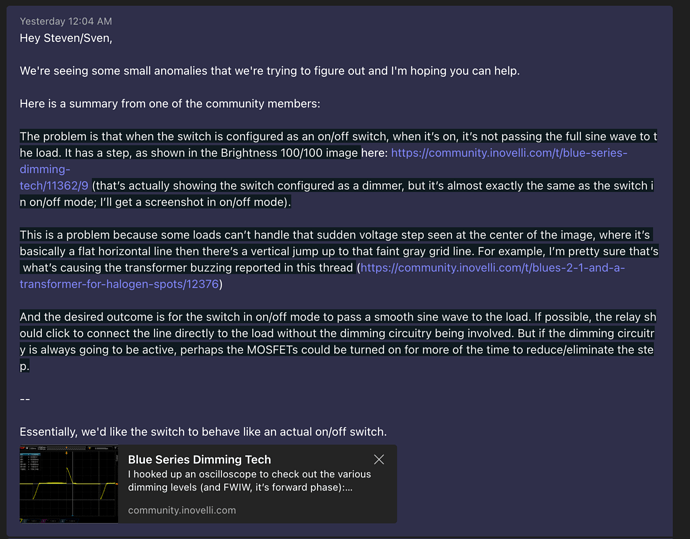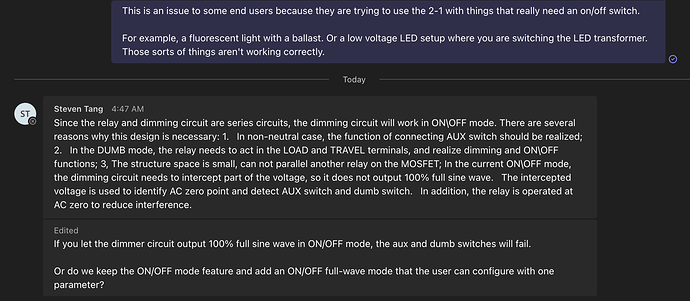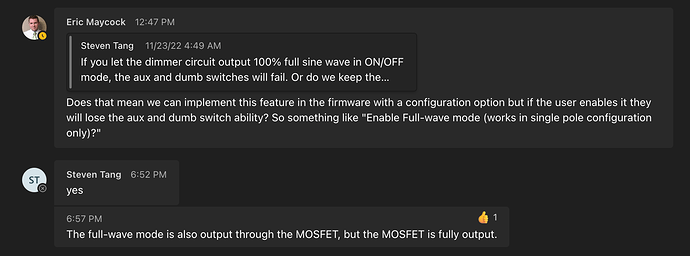I think it was noted triac wouldn’t allow dumb switches in 3+ way to work.
Non-neutral compatibility.
That’s the difference between where the 2 sets of cursor points are. Nothing to do with the waveform output voltage.
So can you discern the Vout with no load?
I think we’re all in agreement that solid-state is the way we’d like to see Inovelli go…
But why? Here’s where I disagree with the design choices. Yes, some (plenty of?) people live in older construction homes without a neutral, but for them I’d rather see a separate sku (potentially with reduced feature set). For the majority (blind assumption of majority with no data backing it) that have neutral wires, why should we suffer loss of function/compatibility (reverse phase dimming)? Alternatively, we know that there are a few niche products that do forward and reverse-phase dimming. Why wasn’t this used for the Blues?
Too much effort on the fancy LED notification bar and smart switch features, imo… not enough time/thought/$ on the non-smart part of the switch. I’m looking at ~50% bulb replacement house-wide to get rid of the annoying buzz caused by forward-phase dimming. I’d gladly pay $10 more per switch for reverse-phase dimming… costs roughly the same as replacing all those bulbs, but far less annoying.
When you only have the cash to engineer one switch, the coverage of both neutral and non-neutral far outweighs other priorities.
Empirical data (that Inovelli has) says that non-neutral is a very broad need in the market. There are more options today, but Inovelli was among a select few that could even accommodate such installations.
We all agree the ability to flip between modes or a second SKU would be preferred, to be clear. It was a business case decision.
Not very easily but that scope can probably do a RMS calculation.
I wish my house had neutrals everywhere. I’d say I’m probably 50/50 split. House was built in 1972.
My house was built in 1985. Most of the time when I pull a switch out of the wall I find a neutral, but not everywhere. None in my garage, not many in my basement.
I purchased the 2-1 because I swore the marketing (or maybe just the pitch thread and subsequent talk about it) said it could be configured as a dimmer or an on/off switch with a real relay. Reading the item page on the website now it doesn’t say it has a relay but I swore that was part of the design.
I also noted it could use a neutral, which is a nice feature. I buy neutral switches as all my locations have them.
As PJF said, the -100V shown in the box is just where the “B” cursor happened to be. I didn’t set it to point at anything, so just ignore BX, BY, etc. The AX value is the only one I set, to show how long the power was on.
The output voltage is what you’d expect, going from about -175V to +175V, or about 120V RMS.
Thanks. I was asking because the top of the curve looks a little flat.
I remember something similar - in fact I thought in the product name “2-1”, the 2 was supposed to be counting the true (relay based) on/off function plus the dimmer function. The relay was to support CFL & “sensitive” loads. Originally, I think the relay on/off was going to be usable for small motors too (like bathroom fans) - but there were certification issues that stopped it being advertised for this.
I too am now slightly confused about what the relay is doing - the current device handler calls it “relay click” - as if it does nothing more than make a noise. I think I read that this was needed to support multi-way connections with dumb switches. My suspicion is that the true relay functionality got removed to enable more non neutral scenarios (if the relay fully connects the line to the load, then there’s no slight voltage drop available to power the switch!)
It switches the output voltage between the Load and Traveler terminals. This is needed for multi-way wiring. The ‘relay-click’ option was added after the fact as a user request
Another chime in here for the sadness that it’s got MOSFETs but not Trailing edge, and the fact that on/off mode isn’t is also not ideal.
I’m used to Insteon, but they had (more or less) 3 SKUs.
Neutral Required Dimmer
Neutral Required On/Off
No-Neutral Dimmer
It looks like trying to cram all 3 of those into 1 SKU has left the product failing at 2 of the 3. You’re like 95% of the way there hardware wise by choosing MOSFETs, it’s quite boggling that they only run forward.
Like others said, I would pay any amount of money for trailing edge dimming, along with real on/off (doesn’t need to be the same SKU)
Please make gen2 of these switches support trailing edge dimming, and either remove the relay or make it actually bypass the dimmers.
The circuit path for a single pole device goes Line → MOSFETS → relay → Load terminal
When the relay is energized (switch turned off) it goes Line → MOSFETS → relay → traveler terminal
Since the traveler terminal is not used in single pole wiring, the relay click completely disconnects the MOSFETS from the load when the switch is turned off.
Thanks! This is the first description that I understood (not that there might not be others out there!).
Under what conditions does the relay have to be enabled? I prefer to have it disabled (i.e.: no click). If I understand it should be enabled when using dumb switches and is not needed to be enabled when using multiple smart switches in a n-way installation.
Following up here as we received a response from the manufacturer and I’d love to get your opinion on it since you’ve graciously taken time out to analyze the switches with an oscilloscope and explained to me why this is important.
I’m not sure if this passes the sniff test with you, but thought I’d just throw it out there and see what you think.
–
Regarding leading vs trailing edge – do you guys think this can be solved via firmware or will it have to be a hardware implementation?
Edit: Actually we got a response around why leading edge was chosen:
“In neutral mode, auxiliary switches and dumb switches are detected. In non-neutral mode, the auxiliary switch is detected. In addition, the detection of alternating current crossing zero. On these detections, leading edge dimming is better than trailing edge dimming.”
In addition to single pole it should also work with 2 (or more) blues bound together since it doesn’t use the normal 3-way circuit logic


